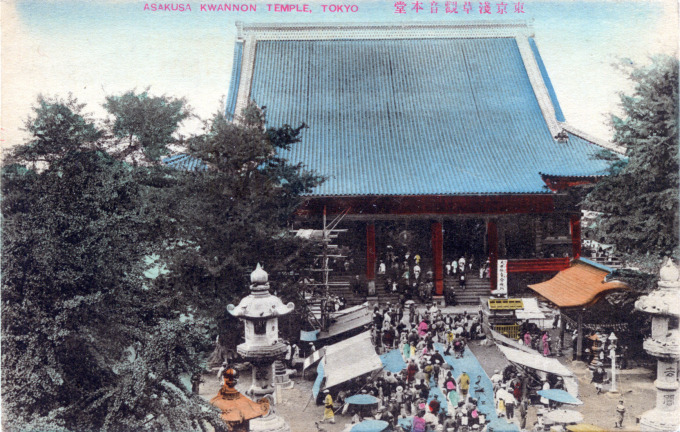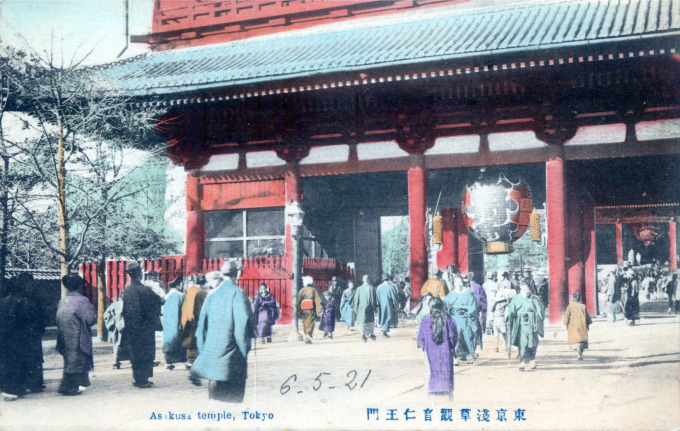
Temple of the Goddess of Mercy, Tokyo, Japan, c. 1910. “Between 5000 and 10,000 worshippers daily. Daily offering more than $50” (equivalent to $1200 in 2014 dollars).
“The leading income source, saisen, consisted of copper coins, the lowest-value currency, which visitors to Sensoji threw into wooden boxes as a small offering. Every Buddhist hall and Shinto shrine on the Sensoji ground had offertory boxes in front of the altars of divine statues.
“Long and perpendicular with an opening at the top formed by parallel crossbars, these boxes were designed to enable visitors to deposit their coins without being hampered by formality, time or congestion.
“Even those who visited Sensoji just for fun usually dropped some coins into the offertory boxes to express their veneration for the Asakusa Kannon.”
– Prayer and Play in Late Tokugawa Japan: Asakusa Sensoji and Edo Society, Nam-lin Hur, 2000

Postcard reproduction, c. 1940, of Hiroshige’s “The Kinryuzan (Sensoji) Temple at Asakusa in the Snow” (Famous Places in Edo series, c. 1843-1845) and the Five-Storied Pagoda.
For a period far longer than any other worship ground in Tokyo, more than fourteen centuries, Asakusa has attracted more of the religiously devout (and the religiously curious) than it has the morally suspect even into the modern era. A late-Meiji period survey indicated over 130 temples and shrines in just Asakusa-ku [ward] alone.
The largest temple in Asakusa Ward, and by far the oldest temple in the city, is Asakusa Senso-ji — more popularly known as the Asakusa Kannon (Kwannon), for its diminutive occupant. The first temple was established in 628 C.E. when a castaway figurine, only 2-inches tall, was netted from the Miyato River by two fisherman brothers. Their find was recognized to be the Kannon, the Buddhist Goddess of Mercy. The village headman recognized the sanctity of the statue and enshrined it by remodeling his own house into a small temple at Asakusa so that the villagers could worship Kannon.
In front of the main hall, clouds of perfumed incense smoke rise continuously from the large bronze urn. Visitors waft the smoke to different parts of their bodies with the belief that whatever ails them will be cured by the incense. Inside the temple, saisen are placed in the offertory boxes and a brief prayer is offered to the deity. The Kannon is supposed to be enshrined behind a net screen in the glittering gold inner shrine.
- Asakusa Sensoji, Tokyo, c. 1910.
- The Nio Gate entrance to Asakusa Sensoji, 1921.
- Asakusa Sensoji festivities, c. 1910.
- Aerial view of the Asakusa Sensoji and surrounding temples, c. 1950.
“The Asakusa Kannon is home, so to speak, to all those who inhabit downtown Tokyo. An Asakusa native need only step onto the temple grounds to feel he is treading his native soil.
“When he returns from years away – when he comes up the stone-paved Nakamise Avenue, goes in through the Nio Gate, and catches his first sight of the great roof – tears spring to his eyes.
“The denizens of downtown Tokyo are all deeply religious. Their faiths vary, but whatever else they believe in, every single one reveres the Kannon of Asakusa.”
– Mistress Oriku: Stories from a Tokyo Teahouse, Matsutaro Kawaguchi, 1969








Pingback: Hanayashiki, Asakusa Park, c. 1920. | Old Tokyo
Pingback: Entrance of Asakusa Temple, Tokyo, c. 1910. | Old Tokyo
Pingback: Hanayashiki, Asakusa Park, c. 1920. | Old TokyoOld Tokyo